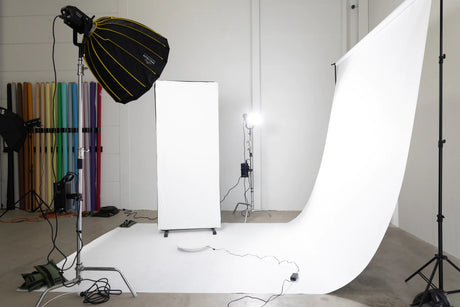Which Godox wireless flash trigger should you choose? The Godox X trigger range has several options to choose from, so if you’re bewildered by the choice, we’ve saved you the time and effort of hunting down the important info with this comparison guide. We’ll look at the Godox X1-T, the Godox Xpro, the Godox X2T, and the latest addition, the new Godox X3, and give you the lowdown on the features of each one.
Godox X1 Wireless Flash Trigger
The Godox X1 Wireless Flash Trigger comes with a choice of mounts for Sony, Canon, Nikon, Olympus, Panasonic, Fuji, and Pentax cameras.
The Godox X1 features an onboard hot shoe on the top, which enables you to mount a flashgun on top of the trigger for extra flexibility.
The controls consist of a channel button, group button, and a mode button, as well as a control wheel and a test button on the top. The battery port is on the bottom, and it takes two AA batteries.
The X1 wireless system supports all of the Godox range of flashes - from speedlites to the new studio strobes, and this includes the portable flashes like the AD400Pro and AD600Pro.
The Godox X1 wireless flash trigger has a wide operating range from 0 to 100 metres (as all the triggers in this range do), so it’s great if you are shooting in a large studio or on location.
This trigger is a bare-bones version of the other triggers, but it is actually quite advanced. While there’s not a lot of buttons to control it, there are a lot of functions to be found in the menu - it can be a bit of a pain to go hunting for them, though.
There are a couple of hidden ports on the side - the micro USB port and a PC sync port. The micro USB port will let you update the firmware (Godox supports their older triggers and they do update the firmware so it’s always worth keeping up to date with this).
As this is the budget version of the Godox wireless flash trigger, then there are some things that it is lacking. Rear-curtain sync function isn’t supported on the Godox X1, but is on the other two triggers in this comparison.
There’s also less control with the flash output (you can only change in one-third stop increments), and no dedicated group buttons (this makes it less user-friendly than the other two triggers in the range).
There are no wireless ID settings on the X1, while the XPro and X2 have them. Wireless ID settings have better connectivity so there’s less interference.
The Godox X1 is the least expensive trigger in the range, and it has a smaller LCD display than the higher-end ones. However, if you want a nice, basic trigger that will do the job and won’t break the bank, then this trigger will suit you.
Godox XPro Wireless Flash Trigger
The Godox XPro Wireless Flash Trigger has a larger LCD display than the X1, but it doesn’t have an onboard hot shoe.
There are many different buttons on the front of the trigger as well as a new scroll wheel.
One of the things Godox hasn’t changed is the locking mechanism that goes on your camera’s hot shoe. There’s been a few complaints that this locking mechanism gets damaged with wear and tear, or that it doesn’t lock that securely into the camera hot shoe.
The trigger itself is full of user-friendly features. On the front are the dedicated group buttons (this is what was lacking on the X1 trigger), which means it’s easy to select groups just by pressing a button.
If you have a lot of lighting groups, then this feature on the Godox XPro trigger makes it simple to control them and change the settings.
Along the bottom of the Godox XPro trigger, you will find the mode, zoom, and sync buttons. You can also control the modelling lamp and go into the menu. The XPro has a proper menu, unlike the confusing custom function menu of the X1.
Here you can cycle through many different options, and you can control up to 16 groups of flashes compared to 5 groups of flashes with the X1.
Another interesting feature of the Godox XPro wireless flash trigger is the TCM function. This allows you to see what setting your flash was at when shot in TTL mode. If you press the TCM button when you shoot in TTL mode it will tell you the flash settings that were used.
If you want to control large groups of off-camera flashes and prefer a user-friendly trigger then the Godox XPro is a good choice.
Godox X2 Wireless Flash Trigger

The newest Godox trigger in the range is the Godox X2 Wireless Flash Trigger. It looks similar to the X1, but it takes the slimline X1 trigger shape and adds a lot of the XPro features (including user-friendliness).
The buttons and placements on the side are similar to the X1. On/off button, and AF assist beam on/off button. The IR port is also the same as the X1.
The top of the Godox X2 flash trigger has more buttons than the X1. There are now dedicated group buttons to allow you better ease of use if you are controlling groups of flashes.
There’s also a new feature - a Bluetooth icon on top, which supports connectivity with the Godox app via Bluetooth so you can control the trigger itself as well as flashes that support the Godox app.
The Godox X2 trigger still has USB-C connectivity, and there’s also a 3.5mm sync port (as opposed to the Xpro’s 2.5mm port).
On the front, there are three buttons with simple functions. The mode button also doubles as a lock button if you want to lock the trigger to prevent accidental button presses.
The menu button does double-duty as the modelling lamp button, and there is also a set button. This button doubles as an ‘all’ button - if you want to change all your settings in one go, hold it down and it will set it to all.
The scroll wheel that used to be on the side on the X1 is now on the bottom (which makes it easier to use).
A major upgrade that lots of Godox customers have been asking for is the change of the hot shoe locking mechanism. It now has a twister lock that lets you lock it in place securely, then you press it down to release.
Godox XProII Wireless Flash Trigger

The XPro was a popular choice among photographers, and this upgraded version packs many new features that make it an even more enticing option for photography enthusiasts. At first glance, the XProII resembles its predecessor; however, it is slightly larger and has a more pronounced grip.
The XPro and XProII share exceptional build quality and sturdiness, but the XProII takes user-friendliness to the next level with its upgraded interface. The buttons are larger and offer better tactile feedback, simplifying the process of adjusting settings while you’re in the midst of a shoot.
The XProII inherits all the professional-grade features of the Godox flash triggers. It supports TTL auto flash across various camera brands, stroboscopic flash, second curtain sync modes, and high-speed sync with shutter speeds up to an impressive 1/8000s. The XProII has an extra-large LCD screen and an intuitive display panel to enhance your workflow further.
One of the most noticeable differences between the two models is the introduction of Bluetooth technology in the XProII. This allows it to sync seamlessly with the powerful Godox Flash Smartphone app. This feature proves invaluable when your camera is out of reach. This TTL wireless flash trigger also offers an optional single-contact function. This feature ensures speedy and sensitive triggering, ideal for those moments when you’re shooting in burst mode. With the single contact triggering, your flash fires rapidly with much shorter intervals, capturing those crucial moments with precision and consistency.
Godox’s commitment to improving user experiences shines brightly in the XProII. With its enhanced features, upgraded user interface, and the convenience of Bluetooth connectivity, this flash trigger is a fantastic choice for photographers looking to elevate their craft.
Godox X3 TTL Wireless Flash Trigger

The Godox X3 flash trigger represents a modern evolution in the Godox X 2.4GHz system, introducing a touchscreen interface and TTL support in a compact, lightweight design. This transmitter offers photographers intuitive controls through its touchscreen, allowing for quick adjustments and easy navigation of settings. Supporting TTL, manual, multi-flash, HSS, and front and rear curtain synchronization modes, the X3 caters to a wide range of shooting needs. Its clear OLED touchscreen not only provides high-contrast information but also allows for precise adjustment of screen brightness, ensuring visibility in various lighting conditions.
One standout feature of the X3 is its two-way TCM mode, enabling seamless conversion between TTL and manual modes with just a few taps on the screen. This feature grants photographers precise control over their lighting setup, whether they prefer automatic exposure or manual adjustment. Moreover, the X3 includes a backup channel scanning feature to mitigate interference and maintain reliable wireless communication in busy shooting environments.
In terms of convenience, the X3 offers fast USB-C charging, allowing photographers to recharge the transmitter from 0% to 100% in just 2 hours. This ensures minimal downtime during shoots and keeps photographers focused on capturing the perfect shot.
Compared to other triggers in the Godox X range, the X3 sets itself apart with its touchscreen interface, compact dimensions, and advanced features like TCM mode and backup channel scanning. These attributes make it an ideal choice for photographers seeking precision, ease of use, and versatility in their wireless flash setups.
Specifications Comparison Table
|
Godox X-System 2.4G |
Yes |
Yes |
Yes |
Yes |
Yes |
|
TTL |
Yes |
Yes |
Yes |
Yes |
Yes |
|
Manual Mode |
Yes |
Yes |
Yes |
Yes |
Yes |
|
Multi-Flash Mode |
Yes |
Yes |
Yes |
Yes |
Yes |
|
Rear-Curtain Sync |
No |
Yes |
Yes |
Yes |
Yes |
|
Flash Output Increments |
1/3rd stop |
1/10th stop |
1/10th stop |
1/10th stop |
1/3rd and 1/10th stop |
|
Minimum Flash Output |
1/256th |
1/256th |
1/256th |
1/256th |
1/256th |
|
Flash Grouping |
Up to 5 groups |
Up to 5 groups |
Up to 16 groups |
Up to 16 groups |
Up to 16 groups |
|
Dedicated Group Buttons |
No |
Yes |
Yes |
Yes |
No |
|
On-Board Hot Shoe |
Yes |
Yes |
Yes |
Yes |
Yes |
|
Sync Port Size |
2.5mm |
3.5mm |
2.5mm |
2.5mm |
N/A |
|
Firmware Port |
Micro USB |
USB-C |
USB-C |
USB-C |
USB-C |
|
Backlit Buttons |
No |
Yes |
No |
No |
N/A / Touchscreen |
|
Backlit Screen |
Yes |
Yes |
Yes |
Yes |
N/A / OLED |
|
Flash Exposure Lock |
Yes |
Yes |
Yes |
Yes |
Yes |
|
Approx. Transmission Range |
1-100 metres |
1-100 metres |
1-100 metres |
0-100 metres |
0-100 metres |
|
TCM |
No |
No |
Yes |
Yes |
Yes |
|
Bluetooth Connectivity |
No |
Yes |
No |
Yes |
Yes |
|
Channels/ID |
32/X |
32/0-99 |
32/0-99 |
32/01-99 |
32/01-99 |
|
AF-Assist Light |
Yes |
Yes |
Yes |
Yes |
Yes |
|
Power |
2 X AA Batteries |
2 X AA Batteries |
2 X AA Batteries |
2 X AA Batteries |
Built-in rechargeable lithium battery via USB-C |
|
Dimensions & Weight |
72x75x52mm 100g weight |
72x70x58mm 90g weight |
90x58x50mm 80g weight |
95x62x49mm 93g weight |
40.9 x 4.7x 39.1mm 48g weight |
Final Thoughts - Which One is Right for You?

Choosing the right Godox wireless flash trigger depends on your specific needs and preferences. Here's a brief rundown to help you make the best decision:
Godox X1: If you're looking for a budget-friendly option that gets the job done without all the bells and whistles, the X1 is a solid choice. It may lack some advanced features like rear-curtain sync and dedicated group buttons, but it offers reliability and functionality at an affordable price point.
Godox X2: For those seeking a balance between affordability and features, the X2 provides a compelling option. With its slimline design, dedicated group buttons, and Bluetooth connectivity, the X2 offers improved usability compared to the X1. However, it lacks the TCM function found in higher-end models.
Godox XPro: If you want a trigger with all the features and don't mind sacrificing the onboard hot shoe, the XPro is the way to go. With its larger LCD display, dedicated group buttons, and TCM function, the XPro offers unparalleled usability and control. It's a favourite among professional photographers for its reliability and user-friendly design.
Godox X3 TTL: The newest addition to the Godox X range, the X3 offers a modern and intuitive solution with its touchscreen interface and advanced features like two-way TCM mode and backup channel scanning. If you prioritise convenience, precision, and versatility in your wireless flash setup, the X3 is worth considering.
Conclusion
Indeed, all the Godox wireless flash triggers offer their own set of advantages, catering to different needs and preferences. For most photographers, having up to 5 flash groups will suffice for their shooting scenarios.
Unless you require the precise control offered by the TCM function to know the flash settings in TTL mode, you may not find it essential. Ultimately, your choice will be influenced by factors such as budget, personal preferences, and the specific demands of your photography endeavours.
We hope that this comparison guide has provided valuable insights to help streamline your decision-making process when selecting the ideal Godox wireless flash trigger for your needs.































